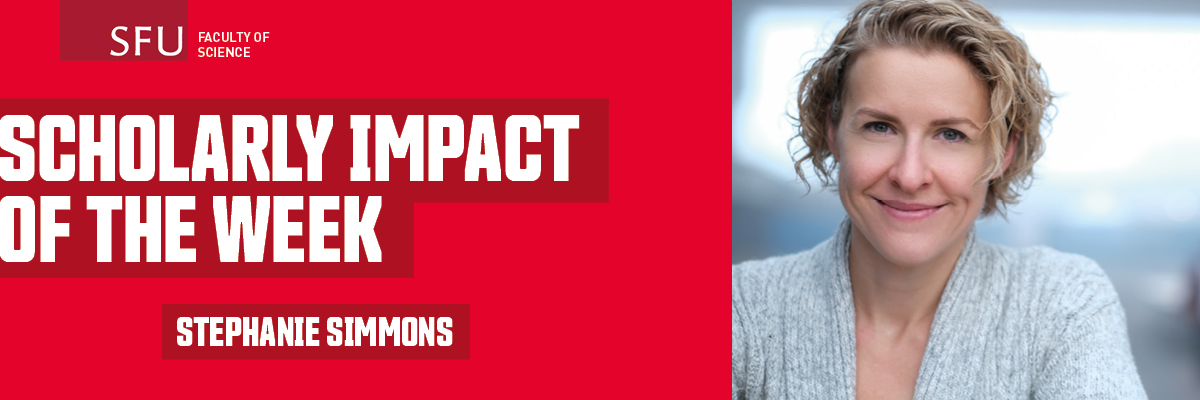
Quantum computing promises to be a transformative technology, potentially solving computational problems that remain out of reach for conventional computers, including even the most powerful supercomputers today.
Researchers have been working to solve the challenges of harnessing quantum characteristics for complex computation for many years. Today, quantum computing is at a pivotal point in its development and SFU researchers are at the cutting edge of this work. As challenges are overcome, unlocking the potential of quantum computing will yield advancements in fields as diverse as drug development, finance, cybersecurity, telecommunications, new materials and machine learning—just to name a few.
Simon Fraser University (SFU) Professor of Physics and Tier 2 Canada Research Chair in Quantum Nanoelectronics Stephanie Simmons is at the forefront of this research. She works collaboratively with the Quantum Algorithms Institute, hosted at SFU, and with the federal government’s Quantum Encryption and Science Satellite mission on quantum communications networks in space. In 2022, Simmons was recognized with the prestigious Arthur B. McDonald Fellowship for her groundbreaking work to develop quantum technologies as well as Canada's quantum strategy.
With Professor Emeritus Michael Thewalt, she also co-directs SFU’s Silicon Quantum Technology Lab. Recently, Simmons, Thewalt and their team published groundbreaking research in Nature magazine—the world’s leading multidisciplinary science journal. Their paper, Optical observation of single spins in silicon, documents their work to demonstrate a high-performance means to link silicon qubits, an essential precursor to building a silicon spin photonically-linked quantum computer.
The research team included SFU Postdoctoral Fellow Daniel Higginbottom and SFU graduate student Alexander Kurkjian, lead authors on the paper. They collaborated with the Department of Physics at the Université de Montréal.
We talked with Simmons about her groundbreaking research.
Can you describe what you recently discovered and how that discovery might bring quantum computing within reach?
The research team has been investigating a new quantum computing architecture that links qubits in silicon with light—we refer to this as photonically linked silicon spin qubits. In previous work, we explored how well a particular defect in silicon, called a T centre, could function as a qubit. In this paper, we go a step further and isolate single T centre qubits for the first time. This milestone is a huge leap for T centre quantum technologies—it is the first measurement of single T centres and in fact, the first all-optical measurement of any single spin in silicon. This measurement has been made possible because the T centre spin-photon interface is so much stronger than anything else discovered in silicon.
T centres are a game changer because they combine long-lived spin qubits with telecommunications band optical transitions. That means they can both store quantum information and network together optically using the same infrastructure as data centres and the global internet.
Importantly, the T centre host is silicon, which has unparalleled prospects for scalability. The modern world is built on silicon microelectronic computers, and the largest quantum computers available today all leverage silicon fabrication technologies.
What is next the next step in this research to bring us closer to a quantum computer?
The next step is on-chip silicon photonic networks with T centres—networking T centre devices with waveguides, switches, modulators and detectors that are already available for the silicon photonic platform. In this work, we have already fabricated tens of thousands of devices with singly addressable T centres, all on a commercial silicon photonic chip, and in the future they will be networked together into large-scale systems. With nanophotonic optical resonators, the T centre spin-photon interface can be enhanced to entangle T centre spins remotely, unlocking quantum communications compatible with existing telecommunications infrastructure.
Do you think we will see quantum computing in the next five to 10 years?
As of right now, every quantum computer is a prototype with very limited (if any) applications, but the applications of more capable quantum computers are now well known. We are seeing an explosion of investment and interest in quantum technologies—from countries announcing their national quantum strategies, to universities expanding their quantum offerings, to more and more companies dedicated to moving quantum from the realm of science to commercial applications. We are on the cusp of major change here.
Quantum computing technology will enable exciting developments in many areas—from drug development to communication infrastructure to materials science. What do you find you most exciting or interesting about this technology?
A scalable quantum computer delivers on the promise of an entire branch of physics. That is a once-in-a generation privilege, and every time in the past when people have done this it has shifted human experience and widened the scope of human knowledge. There are many known applications for quantum computers such as drug discovery, quantum chemistry and cybersecurity—but we have still barely begun to explore what they can do. Few people in the early days of computers could have anticipated the impact of information technology on our lives in 2022, and it is being on the edge of a similar step into new, unknown possibilities that excites me most.
For more:
What quantum technology means for Canada’s future
Faculty of Applied Sciences article
Simmon’s interview on CBC’s Early Edition
Simmon's President’s Faculty Lecture.
SFU's Scholarly Impact of the Week series does not reflect the opinions or viewpoints of the university, but those of the scholars. The timing of articles in the series is chosen weeks or months in advance, based on a published set of criteria. Any correspondence with university or world events at the time of publication is purely coincidental.
For more information, please see SFU's Code of Faculty Ethics and Responsibilities and the statement on academic freedom.